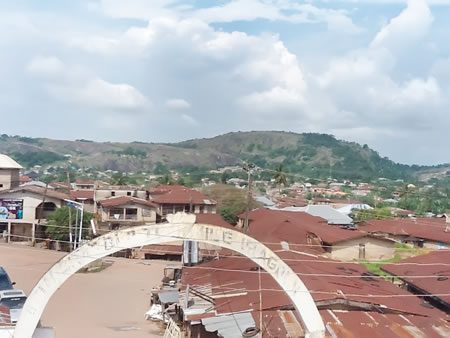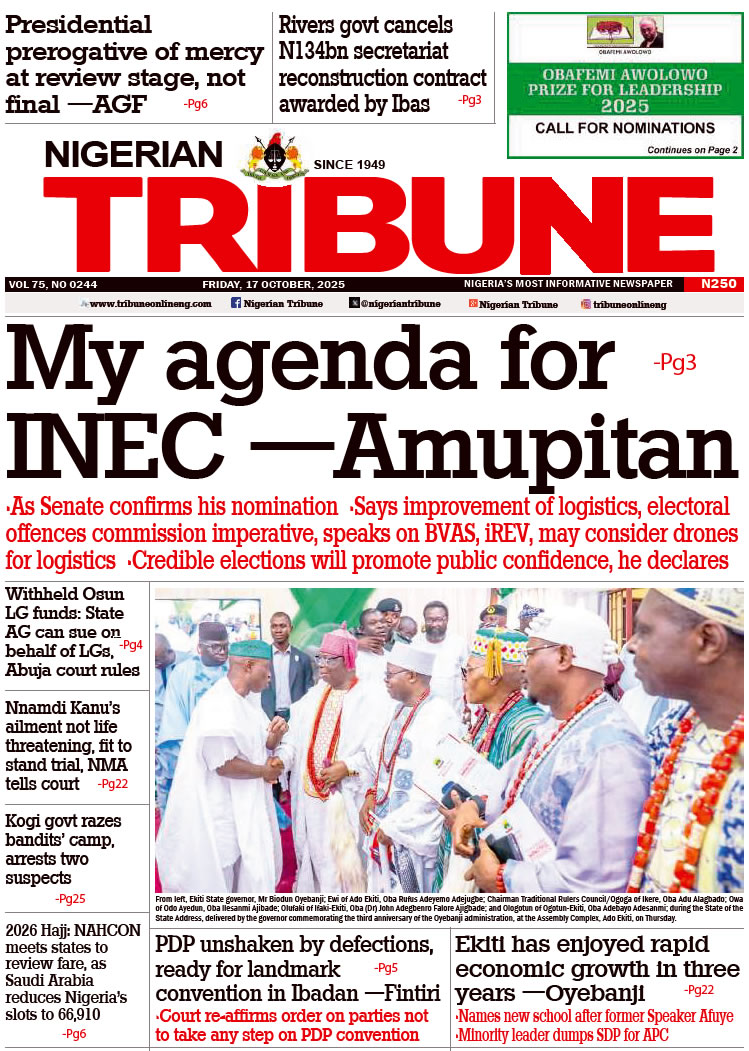
For anybody traversing road networks from Oke-Ila Orangun in Ifedayo Local Government Area of Osun to Iragbiji, Eripa, Iree, Ilesa axis to Efon-Alaye, Erio, Idanre in Ekiti State and some rural communities in Oyo State, there is no doubting the fact that historical mountains and monumental hills are ubiquitous in the south western part of Nigeria.
Though some natural resources, such as gold, gem stones, diamond and other endowments in commercial quantities, are deposited in some of these mountains and hills being explored by a handful of authorised and illegal miners, findings by the Nigerian Tribune indicate that few of these beautiful sceneries had, hitherto in centuries and decades back, played critical roles in shaping the history of the people.
ALSO READ: ‘My 100 per cent loyalty now with Ajimobi’
Sometimes surrounded by shrubs, trees of different species, swamps and grooves, depending on the seasons, with lush green terrains, one can safely aver that mountains and rocky hills in this part of Nigeria are indeed fascinatingly natural structures that cannot be ignored by the natives, travellers and the government.
But a peep into myths and historical facts surrounding mountains and hills, located in Iragbiji community in Boripe Local Government Area of Osun State aptly bring to the fore issues that determine the history, strength and culture of natives, synonymous with hospitality, love and unity. The presence of the mountains and hills are so significant, considering their influence on the panegyrics of its indigenes.
A professor of History in Osun State University (UNIOSUN) in Osogbo, Siyan Oyeweso informed our correspondent that the presence of natural sites or monuments in some communities in the southwestern part of Nigeria can determine panegyrics of the aboriginal inhabitants.
Asked if there is correlation between natural sites in African communities, most especially in Yorubaland and original settlers in such towns, he stated that “geographers and environmentalists can give insights into this. But, what we know is that the hilly environment naturally provides protection, and there is always a nexus between environment and people.”
According to him, “the geographical environment of Iragbiji people indicates that over time, they learnt to tame and understand their environment. The hills during the day can be sunny and very pleasant at night. In all cultures and civilisation, it is always a place for soberness and religious retreats. When you look at all religious organisations today, particularly Christianity and Islam, hilly environments such as Oke Sioni, Oke Baba Abiye, Oke Iragbiji and so on are being explored for different purposes.”
That is why he contended that Iragbijis are eulogised thus: “Iragbiji made up of two rocks male upon the female.”
A visit to Iragbiji which shares boundary with Ikirun from Osogbo axis and Ororuwo community, revealed a rustic setting still grappling with poverty, deprivation and seeming frustration with deplorable road networks begging for government attention.
One of the landmark rocky hills in Iragbiji identified as Okanyilule had long become the pride of anyone who claims ancestral root in Iragbiji as a result of an indelible event which was said to have occurred more than two centuries ago.
Okanyilule hill was then sited at the back of Iragbiji towards the boundary between the community and Obaagun town. The rocky hill with a kind of roundish top edge bulging into the sky had another rocky hill delicately placed by nature on it, thereby making it a cynosure of curious passersby.
The Aragbiji of Iragbiji, Oba Abdul-Rasheed Olabomi, who ascended the throne of his forefathers during the regime of former Governor Olagunsoye Oyinlola of Osun State, said the community is blessed with natural sites that can be explored by the state government for social and economic benefits, capable of aiding the development of Osun State.
Commenting on Okanyilule rocky hill, he said: “the hill is historical to Iragbiji. It is a monument that really depicts and connotes what Iragbiji is. Part of our cognomen says ‘Iragbiji, owners of double hills, one fell down, while the other is still standing.’ Okunyilule has a history dating back to about 200 years ago. There was a dispute over the ownership of the hilly area and the land around it. It involved the then traditional ruler of Obaagun, a neigbouring town to Iragbiji. During that period, the traditional ruler of Iragbiji was Oba Oloyede Dada. Then there were no policemen, there were no soldiers and there were no courts; but traditionally, when issues like that arose, our people in the past had their own methods of settling such disputes. What was prescribed then was to invite all the Obas around Iragbiji area. It involved the then Timi of Ede, the then Ataoja of Osogbo, Oragun of Ila. All of them went to the foot of the hills and asked each of the traditional rulers to prove their ownership.
“The Aragbiji said he was the owner of the land and the hills, insisting that within seven days, one of the two rocky hills, tako-tabo, meaning, one male and one female, standing on each other, will roll down. The then Oloba Agun said nothing of such would happen. To the glory of Almighty God, on the third day, the small rocky hill sitting on the other, rolled down.
“Since then, Iragbiji has considered the Okunyilule hill a monument. In fact every year, people go there to salute the courage of our forebears who were able to stand by the truth. We also commend the gods who allowed the truth to manifest in the rolling down of one of the rocky hills. Today, it is the symbol of Iragbiji on our letter head. Anything we do, we would always allude to the Okanyilule hill. It is one of our prime monuments. We are proud of it.
“Around the Okanyilule hills, we have about four sites. There is a source of water at the Okayilule hills. There is the site where the earliest migrants to Iragbiji called Iledesi settled. There is also a source of water we call Oloti. It was not Oloti from the beginning; it became Oloti later. If you get in there, you will see the marvels of the work of Almighty God, how water gushes out from the base of the rock. It is as site to behold.
“When you leave there, you want to visit Oke Iragbiji itself, which has its own historical connotation. It started with the establishment of Iragbiji, about 600 years ago. History has it that our great grandfather, Sokungbade, was a great man, a hunter. When he arrived here, he went on a hunting expedition to the peak of the hill, Oke Iragbiji. He was chasing an antelope. The antelope entered a hole on top of the hill. History has it that he entered the hole. The antelope and the hunter came out in front of what we now have as the palace. We cannot prove the veracity of that claim but that is in our oral history. In those days, so many things did happen that we feel are unbelievable.
“Since then, our people have been celebrating the hills annually in what we call, Oke Iragbiji Odun Orioke. We normally celebrate it during the last week of July every year. On top of that hill too, we have the Ayeye stream. The stream has its source. The water is always very clean. Then it was forbidden for anybody who was not a prince to go there and draw water or have anything to do with it. The water, before now, was said to be highly medicinal for barren women.
“During our annual festival, people go to the stream to make a lot of vows: the barren, the sick and so on. History has it that about 100 years ago, there was an outbreak of small pox all around the then Yoruba land. It was the water from Ayeye stream that was taken to heal all of the people who had small pox. So, the water is regarded as highly medicinal and spiritual.”
He pleaded with governments at all levels to take advantage of the historical sites and turn them to money spinning platforms.
“If governments at various levels are not so interested, I want to plead with private individuals, corporate bodies and international organisations to invest in the tourist sites as a way of boosting revenues and increasing tourism in Iragbiji and Nigeria,” he said.
WATCH TOP VIDEOS FROM NIGERIAN TRIBUNE TV
- Relationship Hangout: Public vs Private Proposals – Which Truly Wins in Love?
- “No” Is a Complete Sentence: Why You Should Stop Feeling Guilty
- Relationship Hangout: Friendship Talk 2025 – How to Be a Good Friend & Big Questions on Friendship
- Police Overpower Armed Robbers in Ibadan After Fierce Struggle




